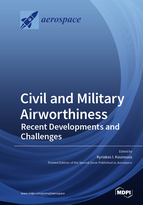Civil and Military Airworthiness: Recent Developments and Challenges
A special issue of Aerospace (ISSN 2226-4310). This special issue belongs to the section "Aeronautics".
Deadline for manuscript submissions: closed (30 June 2019) | Viewed by 117530
Special Issue Editor
Interests: metal plasticity; low cycle fatigue; constitutive modelling; metal additive manufacturing; airworthiness
Special Issues, Collections and Topics in MDPI journals
Special Issue Information
Dear Colleagues,
The “Civil and Military Airworthiness: Recent Developments and Challenges” Special Issue aims to cover a broad coverage of contemporary issues and research conducted in the fields of initial and continuing airworthiness, both in the civil and military aviation. This Special Issue offers the opportunity to academics, researchers and industry practitioners working in the broader airworthiness area to publish their original research and review articles.
Particular emphasis will be given on state-of-the art review works and theoretical, experimental, computational research and applied engineering work conducted on:
Initial Airworthiness
- Aircraft and aeronautical components testing and certification;
- Qualification and certification of new technologies, i.e., supersonic transport aircraft, electric and hybrid propulsion aircraft, etc.
- Certification of systems specific to military aircraft;
- Qualification and certification of additively manufactured metallic and non-metallic safe/non-safety critical aircraft parts;
- Advanced testing and computational techniques for composite aircraft testing and certification;
- Reliability engineering methodologies and practice in aircraft design and engineering changes;
- Safety and risk assessment methodologies and practice in aircraft development;
- Human factors’ considerations in aircraft design.
Continuing Airworthiness
- Safety and risk assessment in aircraft flight and technical operations;
- Reliability analysis of aircraft systems and components;
- Continuing airworthiness management practice in civil and military aviation;
- Development and optimization of aircraft maintenance programmes;
- Development and optimization of military aircraft structural integrity (ASI) management programmes;
- Effective and efficient inspection and sustainment techniques for composite aircraft;
- Human factors in aircraft maintenance and operations;
- Safety management effectiveness in flight and technical operations;
- Quality management and optimization in aircraft maintenance organisations;
- Aircraft technical and non-technical cost analysis and estimation techniques.
Dr. Kyriakos I. Kourousis
Guest Editor
Manuscript Submission Information
Manuscripts should be submitted online at www.mdpi.com by registering and logging in to this website. Once you are registered, click here to go to the submission form. Manuscripts can be submitted until the deadline. All submissions that pass pre-check are peer-reviewed. Accepted papers will be published continuously in the journal (as soon as accepted) and will be listed together on the special issue website. Research articles, review articles as well as short communications are invited. For planned papers, a title and short abstract (about 100 words) can be sent to the Editorial Office for announcement on this website.
Submitted manuscripts should not have been published previously, nor be under consideration for publication elsewhere (except conference proceedings papers). All manuscripts are thoroughly refereed through a single-blind peer-review process. A guide for authors and other relevant information for submission of manuscripts is available on the Instructions for Authors page. Aerospace is an international peer-reviewed open access monthly journal published by MDPI.
Please visit the Instructions for Authors page before submitting a manuscript. The Article Processing Charge (APC) for publication in this open access journal is 2400 CHF (Swiss Francs). Submitted papers should be well formatted and use good English. Authors may use MDPI's English editing service prior to publication or during author revisions.






